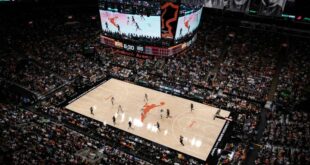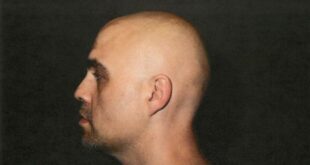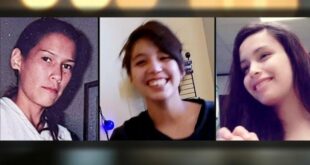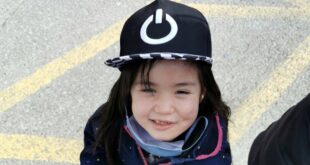School district in Coquitlam, B.C., has teamed up with kʷikʷəƛəm First Nation to custom make a digital world

As puffs of smoke rise from a fire inside a kʷikʷəƛəm (Kwikwetlem) big house, middle school student Elsa Romey reaches over to help her twin sister Maya turn soft cedar wood into a box with an inlay-carved lid.
"This is a bentwood box," she tells CBC News. "You can store stuff in it."
"Important stuff," Maya adds. "Things that have meaning to you."
On this day, their class is busy placing cedar bark they collected in the forest into the boxes they made. Elsa explains the soft bark can be used for everything from multi-coloured blankets to hats and weavings.
Outside the big house, two cedar welcoming figures tower amid a landscape of trees, mountains, and rivers teeming with salmon.
But the Romey twins and their classmates can't smell the fragrant cedar planks of the building, nor feel the warmth of its central fire, nor hear the calls of the eagles soaring outside.
They are actually inside a classroom at École Montgomery Middle School in Coquitlam, B.C., playing the immensely popular video game Minecraft.

B.C. teens show off their Indigenous cedar box-making skills—in Minecraft
2 days ago
Featured VideoTwin sisters Elsa and Maya Romey demonstrate how their peers at École Montgomery Middle School in Coquitlam, B.C., are learning about the local kʷikʷəƛəm First Nation's culture and history, thanks to a new immersive world within the popular video game Minecraft.
The digital Indigenous environment is the creation of School District 43, which teamed up with kʷikʷəƛəm First Nation educators to develop an area within the game to learn about the First Nation's culture and history.
"You go like this, then you drag it around," Elsa explains as she taps buttons on the laptop touchscreen. "These hardest tasks would be very useful to do in a group.
"It's a really fun way to learn for people who don't want to just sit in class and read about First Nations."
The best-selling game Minecraft allows multiple players to create structures, objects and characters using clusters of digital blocks within a deliberately pixelated, three-dimensional environment.
That popularity of the game among students is being tapped by schools in Coquitlam, located just east of Vancouver, to create an immersive and co-operative space for Indigenous storytelling in local classrooms.
But while the existing Minecraft world has trees, mountains, fish and birds, some of the most important items for many B.C. Indigenous cultures were missing, such as Western red cedar.
So those developing the new world — called A Pacific NorthWest Coast Experience — enlisted help from Microsoft, which owns Minecraft, to add the iconic species. The world also features red-and-green sockeye salmon spawning in rivers.
A Pacific NorthWest Coast Experience is the first of nearly a dozen Indigenous-created worlds in the works, school officials said.
'It's amazingly done'
John Peters, an elected councillor with kʷikʷəƛəm First Nation, first started playing Minecraft as a way to connect with his son, who is on the autism spectrum.
"This is just the welcoming post or the house post. This is a big house. It's amazingly done," he tells CBC News as the game appears on a large screen behind him.
"Seeing something like Minecraft that incorporates the teachings of kʷikʷəƛəm First Nation is just simply amazing," Peters added. "I'm actually so excited that I can't wait to have my turn with my sons on this game."
Teachers across B.C. have already been using Minecraft Education, a school-appropriate version of the world-building game, for several years for a number of topics.

B.C. school uses Minecraft to teach Indigenous heritage
3 days ago
Featured VideoThe kʷikʷəƛəm First Nation, School District 43 and Microsoft have teamed up to create a new Minecraft world for Indigenous storytelling in the classroom. Our Maurice Katz visited École Montgomery Middle School, where Indigenous classes are being taught using the popular video game.
Rob Cowie, School District 43's Indigenous education resource teacher, says using a popular game to integrate Indigenous knowledge and perspectives into the classroom made sense.
"We have this wonderful tool called Minecraft," recalled Cowie. "Can we find a way to use that to help with Indigenous storytelling here in our territory?
"I thought, what a wonderful idea, and it just grew from there."
Cowie said the district's requests for local modifications to the world were eagerly received by the game's creators.
"We have to have cedar — it is the heart of the whole community here on the West Coast," he said. "They were gracious enough to actually rename and re-skin certain trees that were in the game so that we could have cedar.
"We didn't have bears, [Minecraft] had polar bears, but not bears in the Lower Mainland."
While Minecraft is normally a world of almost limitless possibilities to collect resources for world-building, the kʷikʷəƛəm version sets unique limits — for instance how many salmon players can harvest.
"We're only allowed to catch one," Montgomery student Ara Bella explained. "We want to be resourceful and not waste food."
For Elsa Romey, the game has been a chance to make her curriculum more engaging — and collaborate on challenges with her peers.
"We learned a lot through this, because it was really fun and we worked together," she said. "Since we're co-operating, it makes it easier."
ABOUT THE AUTHOR
Journalist
David P. Ball is a multimedia journalist with CBC News in Vancouver. He has previously reported for the Toronto Star, Agence France-Presse, The Globe & Mail, and The Tyee, and has won awards from the Canadian Association of Journalists and Jack Webster Foundation. Send story tips or ideas to david.ball@cbc.ca, or contact him via social media (@davidpball).
*****
Credit belongs to : www.cbc.ca
 MaharlikaNews | Canada Leading Online Filipino Newspaper Portal The No. 1 most engaged information website for Filipino – Canadian in Canada. MaharlikaNews.com received almost a quarter a million visitors in 2020.
MaharlikaNews | Canada Leading Online Filipino Newspaper Portal The No. 1 most engaged information website for Filipino – Canadian in Canada. MaharlikaNews.com received almost a quarter a million visitors in 2020.






